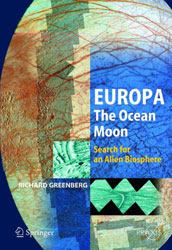
The moon Europa orbits the giant gas planet Jupiter. The recent Galileo probe and the more dated Voyager probe traveled past this moon and, with their collection of sensors, they took measurements. Galileo, even with its failed main communication antenna, was kept busy taking pictures. Some images filled in the blanks remaining from Voyager. Others were high resolution views of noteworthy features. Other sensors already revealed that a water-ice layer lies overtop an earthen core. However, there are almost no craters. So the surface is relatively new. No one knows how the surface refreshes itself but one option is for local heat from the ground to melt the overburden of ice. Of course, water, heat and some other choice ingredients are the ingredients for life. This possibility is what gives Europa its present allure.
Europa is front and centre throughout this book and in it Greenberg pushes a number of related agendas. First and foremost he classifies aspects of the images and associates them to possible causes. There is no expectation for the viewer to be a wiz as Greenberg starts slow and builds up. A history lesson begins the book. Galileo’s personal observations start the ball rolling, then Greenberg continues on with eccentricity, rotation, tides and stresses. The detail can get nitty-gritty, but not to such a depth as to loose the general reader. Suffice it to say that he’s very thorough with his description of the likely forces at play on Europa’s surface.
Having completed this background, Greenberg goes on to describe each of the classifications he and his team made from the images. Using the complete set transmitted by the Galileo probe, he presents, in a clear and thorough fashion; exotic ridges, bounding cycloids, complex chaos areas and spotty lentiuclae. But he doesn’t just leave the descriptions standing on their own. For each he provides an hypothesis for their formation and often he supports these with results from computer simulation. Further, ready references to nearby black and white or colour images allow the reader to also view the special shapes. Greenberg’s explanations are clear, succinct and well supported.
Another agenda that Greenberg raises in this book regards the politics of scientific exploration. Though Greenberg is part of the Galileo Imaging Team, he bemoans its seemingly military structure over his preferred equal weighted collective. His concern is that science might become subject to personal issues. As such, there are many references to Greenberg or a member of his team being harangued by the status quo who were supporting their own canonical model. Because of this, an interesting undertone of uncertainty exists throughout the book as well as perhaps a tinge of animosity. Yet, these don’t distract from the science and do add a certain human perspective to the writing.
A final agenda or objective is an apparent desire to capture and store hard won knowledge. The perception is that the research funding is running out and the team members are disbanding. Hence, for posterity’s sake, the results of many years’ and many peoples’ work are brought together between two covers.
Though relying upon little technical information, Greenberg has written an exemplary book. Chapters stand well on their own and each leads smoothly into the next. The sum total defines a comprehensive hypothesis regarding the shaping of Europa’s surface. Sub-theories have a sound basis and each have an excellent description. A plethora of images allow the reader to appreciate the team’s challenges and their hard won results. Because of this, the book is a solid, self-contained overview of Europa that would be a great reference for a researcher or an interesting read for anyone wanting to check-out what’s happening at one of the leading edges of planetary science.
Being at the forefront of science is exhilarating on its own. Sharing the wonders with other people increases the satisfaction even more. Richard Greenberg’s Europa, The Ocean Moon summarizes his research and that of his colleagues resulting from the Galileo probe’s mission to Jupiter. Europa’s ice surface may seem haphazard in construct but with intuition and perception, we can see how science can make reason out of this exotic world.
Review by Mark Mortimer
